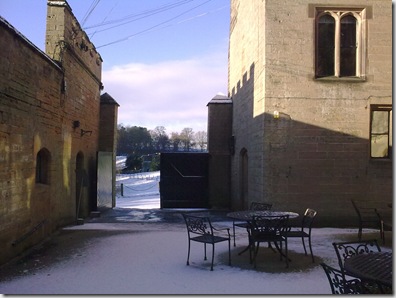St. James’ Church, Papplewick, Nottinghamshire.
Linby and Papplewick are two of my local villages, both distinctive and attractive due in no small measure to their structure of yellow sandstone quarried from Linby itself. The stone is slightly reminiscent of Cotswold stone in its warm, cosy glow both in winter and summer. There’s more than the average share of history from within the environs of these two neighbouring villages but perhaps that is largely a matter for a separate look at them on another occasion. This story today is of two local churches, very disparate in the tales they have to tell.

Walking with my partner’s mother and aunt who are visiting from either side of the vast plains, forests and mountains of Canada, we set off strolling over the narrow path alongside a newly ploughed field after passing by a small selection of grand homes clearly inhabited by the well-heeled of the locality. Ours was a simple short walk for posterity and fresh air’s sake in the main. It was however to be punctuated by one or two sights I had never seen in my time in Nottinghamshire.
Shortly after we passed over two fields we came to the idyllic setting of a fisherman’s pond damned from the River Leen. Ours was but a jealous peek inside the hedge from a quaint little bridge as the pond stocked with coarse fish loomed through the bows of the overhanging trees and undergrowth. A stern warning of privacy and a secured gate stopped us from entering and walking the banks of the pond. We did however see several trout in the brackish water beneath us on the bridge.
Another field brought us in sight of Papplewick’s principal place of worship, St James’, a tiny church nestled amongst the oaks and birches in its original Sherwood Forest setting. Our slice of good fortune was that for the first time I had ever walked this path the church was actually open due to three ladies preparing decorations for Harvest Festival festivities the coming Sunday. A scout around the churchyard saw the gravestone of Lord Byron’s servant buried in the 1820’s, members of the local Montague family and the local regiment of the Sherwood Foresters were also interred in the longish grass.
Luckily we were invited inside to inspect the little church. One can only smile at the faith and devotion that is evident in these small shrines everywhere around us dating back so many hundreds of years. I find this very touching still. A small stairway beckoned to an upper balcony that ran the length of the church which just had to be explored. We were told that this area was reserved for worshippers from a ‘higher’ social class – perhaps not in keeping necessarily with the message communicated in the church I reasoned to myself. We were told that the monks from Newstead Abbey would rest, take shelter and pray at St James’ whilst walking the many miles to Lenton Priory. It was not difficult to imagine the men of the nearby Augustinian order emerging through the pleasant greenwoods of Nottinghamshire and into this beautiful place all those hundreds of years ago
Clearly the quaint little church of St. James’ at Papplewick would be a beautiful, cosy place to worship on a cold, wintry Nottingham evening. I imagined the warm, soft glow of its lights through stained glass, like embers ushering people to it through a forest floor laden with brown oak leaves. The fact that people had been attracted there, doing just that since the twelfth century laid claim to that thought.
One last observation was of the large, impressive yew tree in the churchyard. Legend tells us that the forest outlaws and yes, even Robin Hood himself were said to have used the tree to fashion their longbows from, the wood being of a perfect nature for the strength and suppleness required of the mighty and storied English weapon. Other stories tell us of a different reason for the presence of yew trees in so many churchyards. One theory is that yews actually predated the churches and were used as pagan meeting places which offered shelter under their thick, shroud of umbrella-like branches, that churches merely sprang up in the same places due to their suitability as places of worship. Nobody really knows but I find either story equally palatable.
I cannot leave the subject of St, James of Papplewick without relating its further involvement with the legend of Robin Hood. It was one of Robin’s supposed main collaborators, minstrel, Alan A’Dale who was reputed to have been actually married here, (though some say he is buried here alternatively). I have no idea of the truth of these legendary tales but one visit to Papplewick leave one in no doubt that many forest happenings could have occurred in the secluded depths of this parish. Further evidence of the royal foresters can be seen inside the church with two tombstones carved with the archer’s longbow and hunting horn.
Whatever one’s ability to suspend belief for a moment, these artifacts are truly magical and open the history book wide to a chapter hundreds of years ago that was so important to this area.
Truly St. James’ Church in the parish of Papplewick, Nottinghamshire is a most remarkable place.
(Continued)








